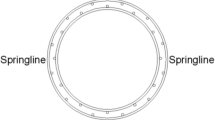Abstract
Traditionally, most equipment that was used for containing corrosive solutions and fumes for the steel industry was fabricated from steel with a rubber-lined interior. An additional acid-resistant brick lining was used to protect the rubber lining and also to act as thermal insulation. This investigation focussed on a geopolymer material that would simultaneously solve the two issues, recurrent acid leakage from the brick-lined structure and minimal thermal stress during operation. The scope of this project was limited to identify the extent of weight loss in a strong HCl acidic environment for a standard geopolymeric composite at 90 °C. Accelerated tests on geopolymer samples were conducted over 110 days and the weight loss results were extrapolated over a time period of 300 days. Visual inspection showed that OPC had a reduced diameter after 40 days of acid exposure, and therefore, the overall acid penetration for OPC was significantly higher than GPC. The mechanism of weight loss or material degradation was not the key aim in this investigation, rather we aimed to obtain a new composition to withstand highly acidic condition (which are not encountered with ordinary Portland cement (OPC) concrete, e.g. in sewage conditions). The average weight loss of a theoretical slab of geopolymer sample in accelerated test conditions (90 °C and 22% HCl) is found to be 1.8 wt% in 60 days for single-face exposure and the average thickness loss predicted for a 40 mm thick slab is about 3.5% after 300 days of exposure in operating conditions of 18% HCl and 80 °C after reaching steady-state weight loss. This is significantly better compared to a standard concrete and brick slab or steel-lined rubber slab. This initial investigation indicated that with further scientific investigation and understanding of the material, the application could be broadened to further minimise acid corrosion over longer time periods (10 years).








Similar content being viewed by others
References
Davidovits J (1994) In: Mehta K (ed) Proceedings of V Mohan Malhotra symposium, ACI SP
Perera D (2007) In: Freiman S (ed) Proceedings of the 1st international congress on ceramics, The American Ceramic Society
Hardjito D (2005) PhD thesis, Civil Engineering & Computing Department, Curtin University of Technology, Perth, Australia
Fernandez-Jimenez A, Palomo A et al (2006) ACI Mater J 103:106
Van Jaarsveld GS, Van Deventer JSJ, Lukey GC (2003) Mater Lett 57:1272
Bakharev T (2005) Cem Concr Res 35:658
Chindaprasirt P, Chareerat T et al (2007) Cem Concr Compos 29:224
Davidovits J (1988) In: Davidovits J (ed) World congress of geopolymer 1988, Institute of Geopolymer, Saint Quentin, France
Van Jaarsveld JGS, van Deventer JSJ, Lukey GC (2002) Chem Eng J 89:63
Palomo A, Grutzeck MW, Blanco MT (1999) Cem Concr Res 29:1323
Bakharev T, Sanjayan JG, Cheng Y-B (1999) Cem Concr Res 29:113
Shi C (1996) Cem Concr Res 26:1789
Palacios M, Puertas F (2006) J Am Ceram Soc 89:3211
Xu H, van Deventer JSJ (2002) Miner Eng 15:1131
Fan Y, Yin S, Wen Z, Zhong J (1999) Cem Concr Res 29:467
Buchwald A, Kaps Ch, Hohmann M (2003) In: Proceedings of the 11th international congress on the chemistry of cement (ICCC), Durban, South Africa, p 1238
Rangan BV (2007) In: Nawy EG (ed) Concrete construction engineering handbook. CRC Press, New York
Bakharev T (2005) Cem Concr Res 35:1224
Kriven WM, Bell JL (2004) Ceram Eng Sci Proc 25:99
Arjunan P, Silsbee ML, Roy DM (2001) In: 2001 international ash utilization symposium, Center for Applied Energy Research, University of Kentucky
Duxson P, Fernández-Jiménez A, Provis JL, Lukey GC, Palomo A, van Deventer JSJ (2007) J Mater Sci 42:2917. doi:https://doi.org/10.1007/s10853-006-0637-z
Duxson P, Lukey GC, Van Deventer JSJ (2007) J Non-Cryst Solids 353:2186
Rangan BV (2006) Indian Concr Inst J 7(3):9
Kovalchuk G, Fernandez-Jimenez A, Palomo A (2007) Fuel 86:315
Hardjito D, Wallah SE, Sumajouw DMJ, Rangan BV (2004) Paper presented at concrete world: engineering & materials, ACI, Mumbai India, 9–12 Dec 2004
Sofi M, van Deventer JSJ, Mendis PA, Lukey GC (2007) Cem Concr Res 37:251
Song X, Maroozeky M, Brungs M, Chang ZT (2005) In: Davidovits J (ed) World congress of geopolymer 2005, Institute of Geopolymere, Saint Quentin, France
Schoeppner GA, Tandon GP, Ripberger ER (2007) Compos Part A Appl Sci Manuf 38:890
Pardo A, Merino S, Merino MC, Barroso I, Mohedano M, Arrabal R, Viejo F (2009) Corros Sci 51:841
Ammar-Khodja I, Picard C, Fois M, Marais C, Netchitaïlo P (2009) Compos Sci Technol 69:1141
Duxson P, Provis JL, Lukey GC, Mallicoat SW, Kriven WM, Van Deventer JSJ (2005) Colloids Surf A 269:47
Acknowledgements
The authors are grateful to Dr. Prabir Sarker and Ms. Monita Olivia for helpful discussion and sample testing. This work was funded by a Curtin Linkage Grant and the authors are thankful for the financial support to conduct some of the testing.
Author information
Authors and Affiliations
Corresponding author
Rights and permissions
About this article
Cite this article
Chaudhary, D., Liu, H. Influence of high temperature and high acidic conditions on geopolymeric composite material for steel pickling tanks. J Mater Sci 44, 4472–4481 (2009). https://doi.org/10.1007/s10853-009-3678-2
Received:
Accepted:
Published:
Issue Date:
DOI: https://doi.org/10.1007/s10853-009-3678-2




